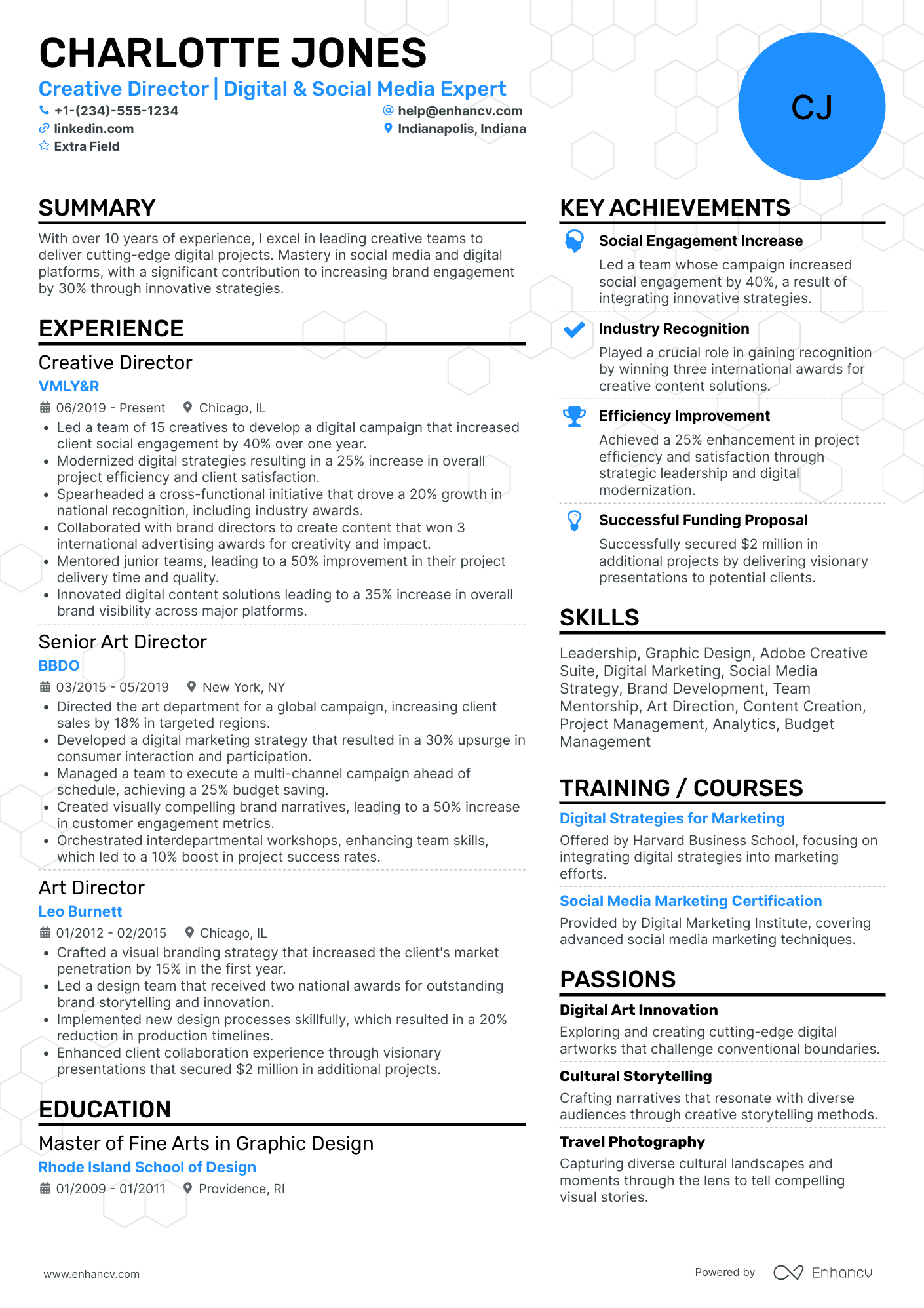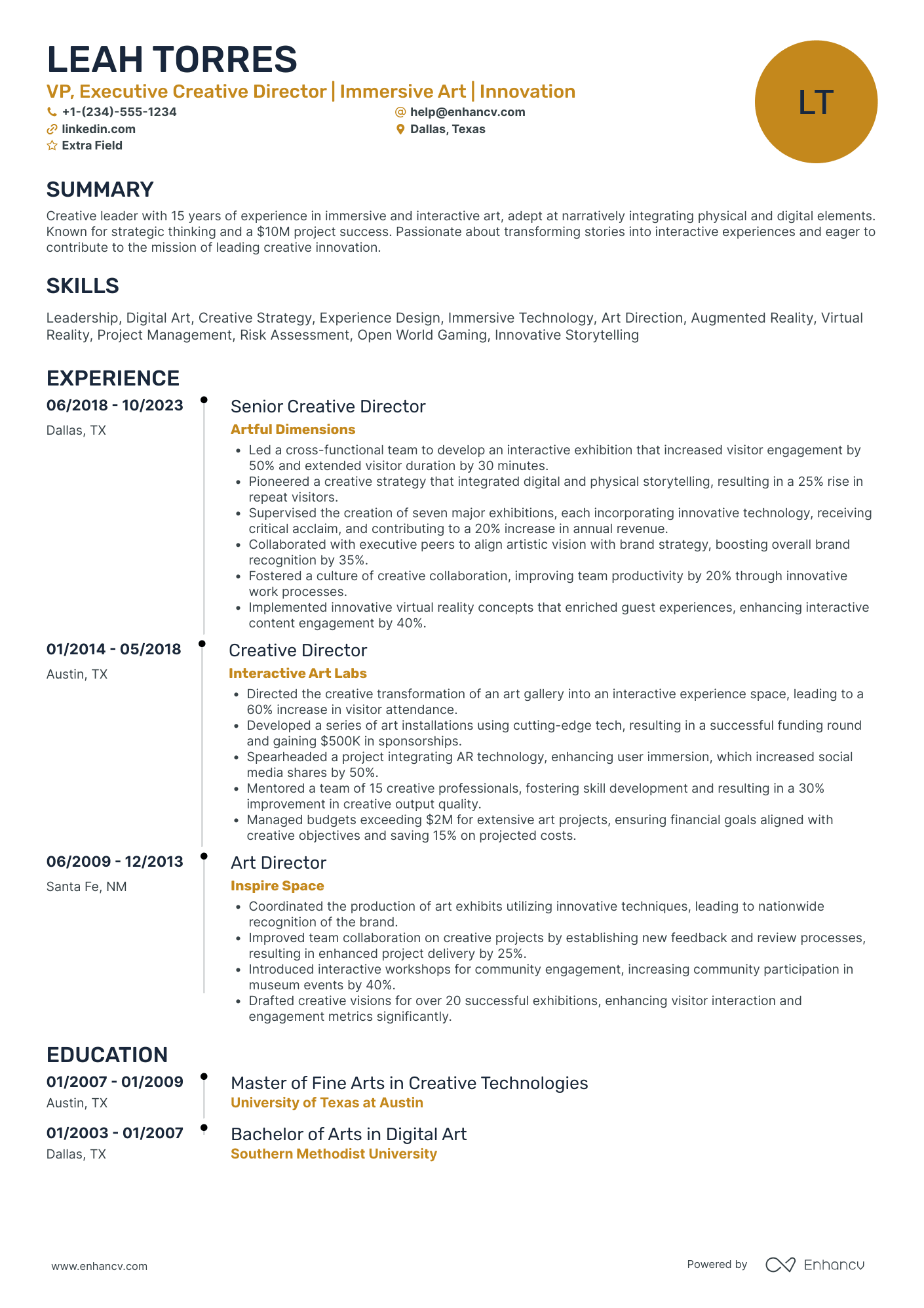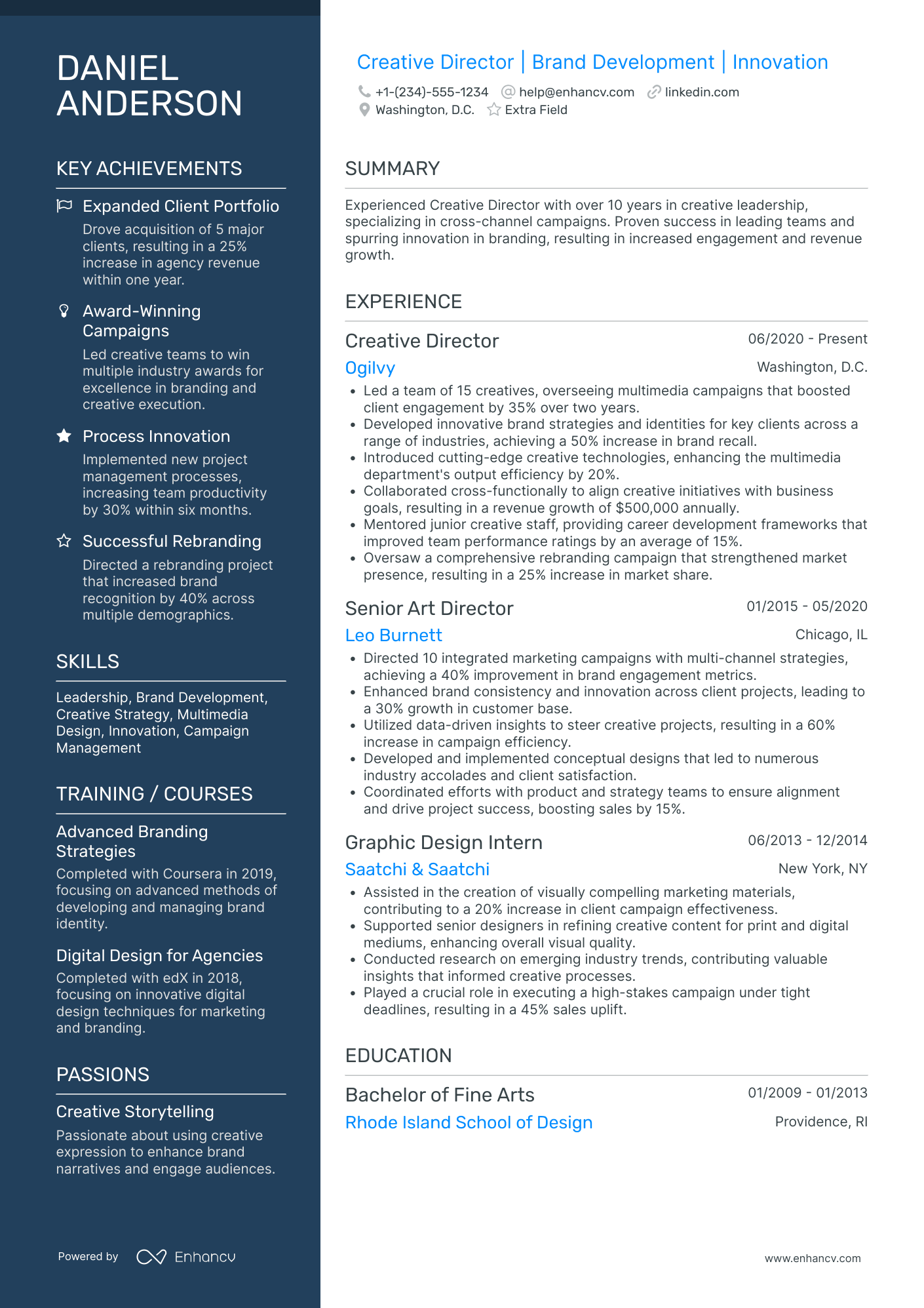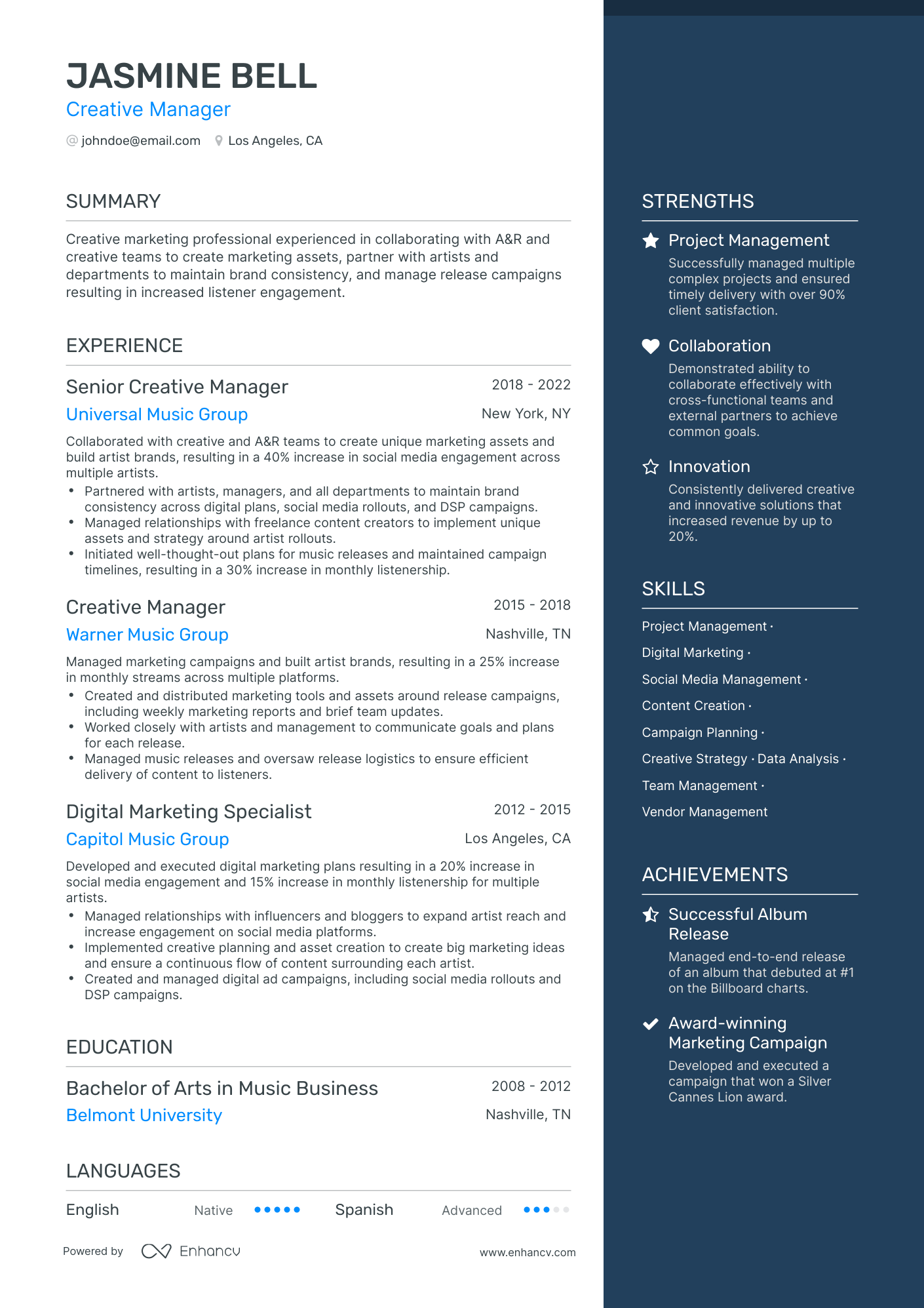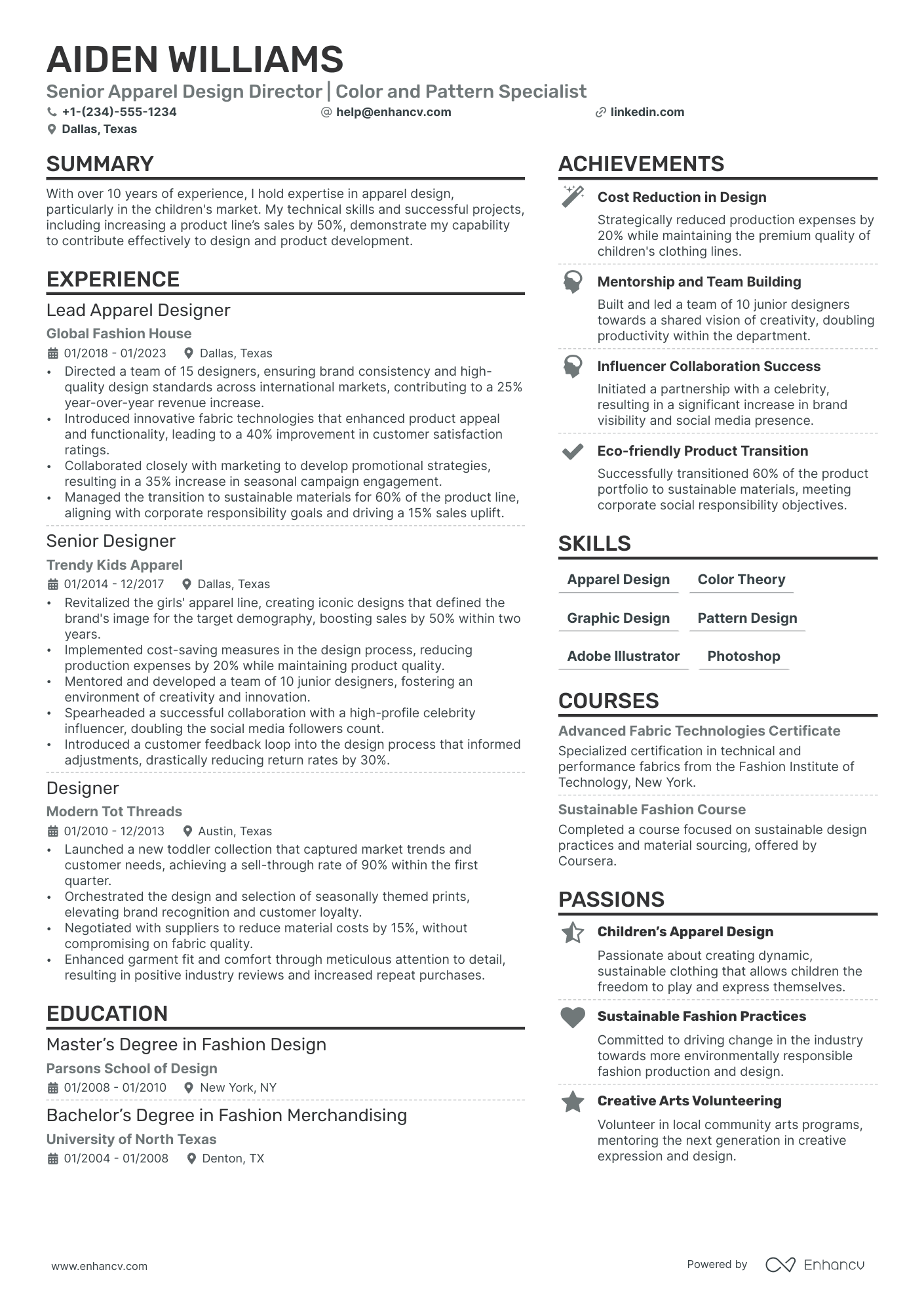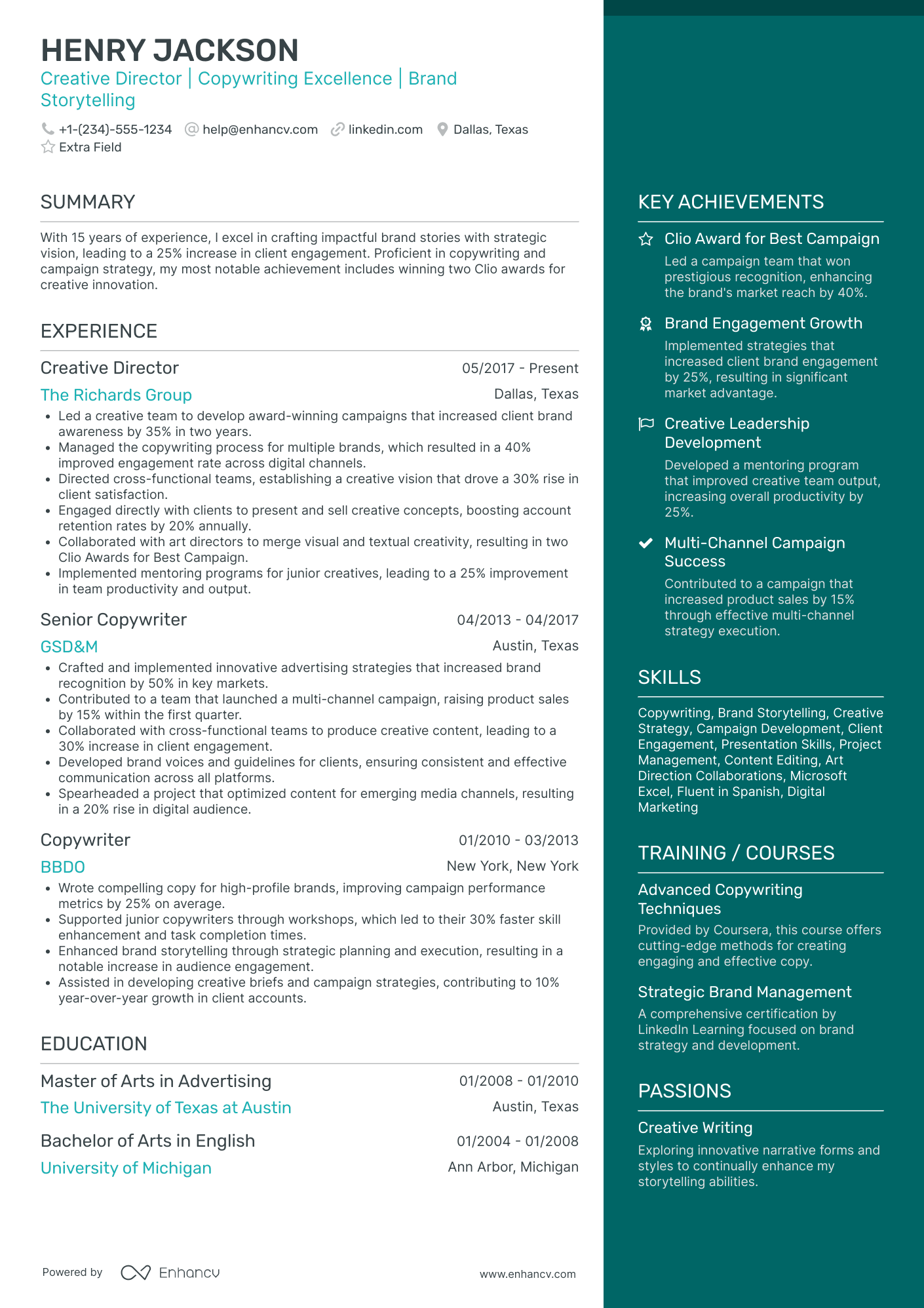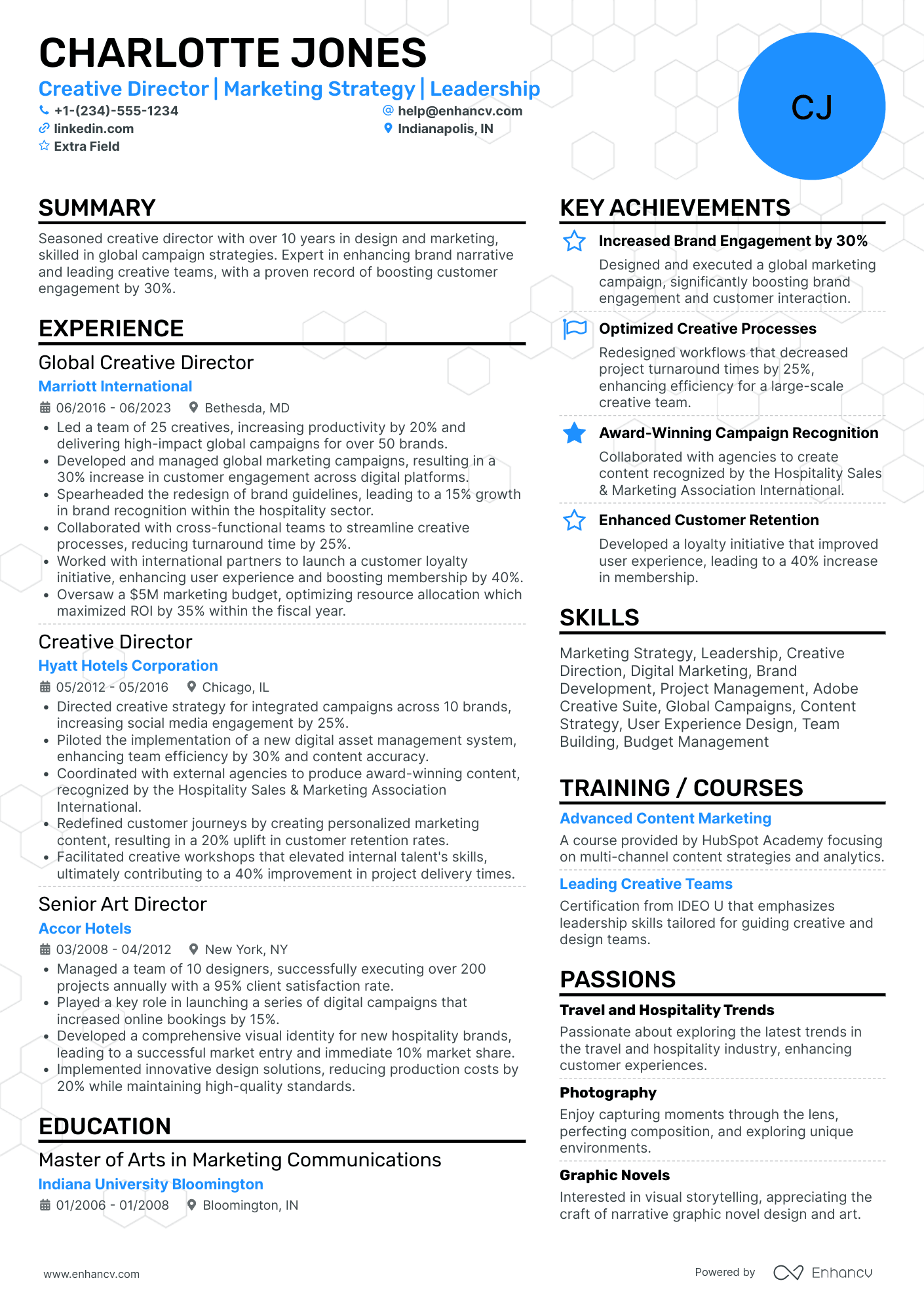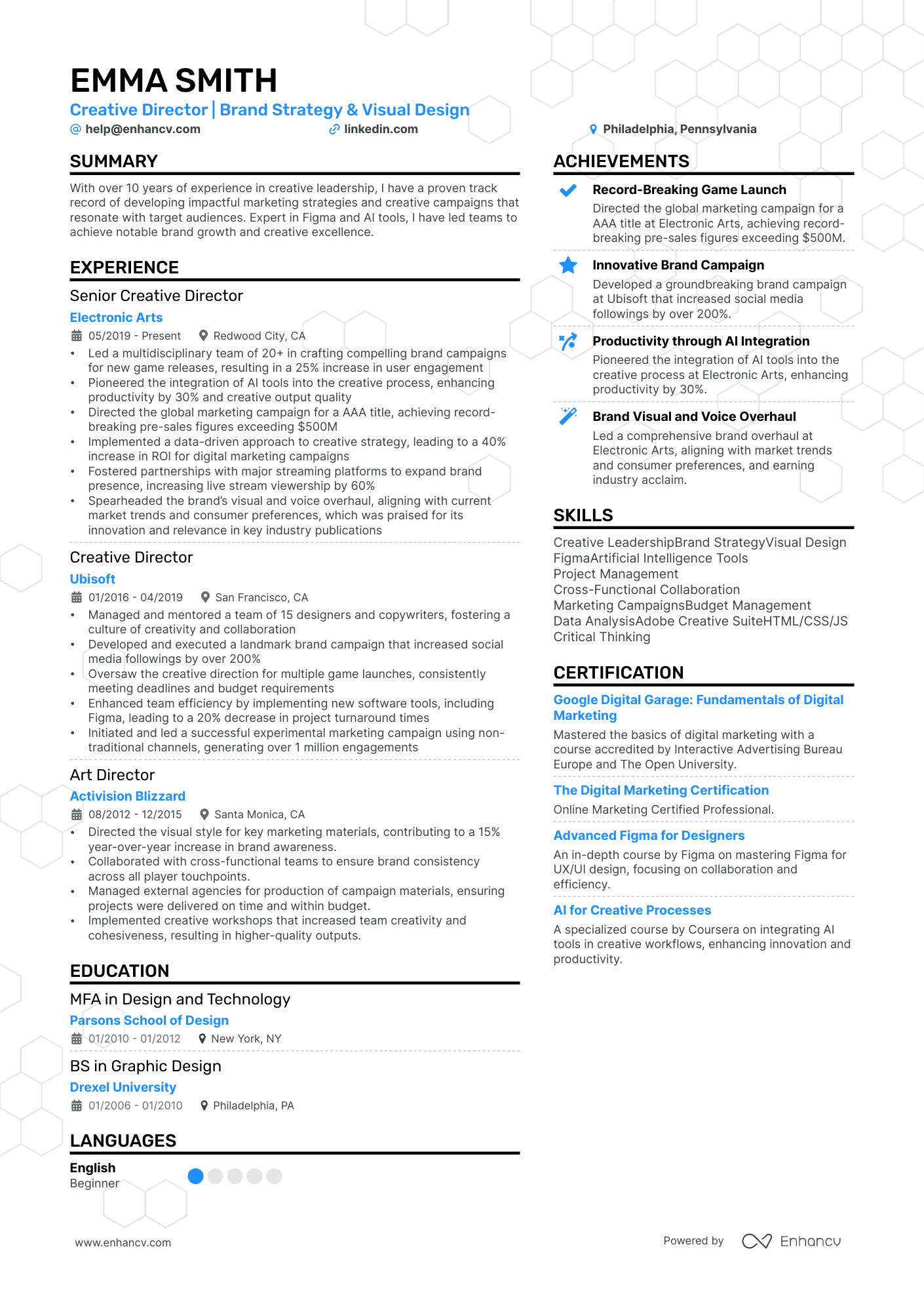You’ve got an eye for what sells, have expertise in marketing, and know how to inspire creative teams. As you’ve risen to the top in your field to become a creative director, you probably haven’t dusted off your resume in some time. Now, you’re back on the market and need to update your resume.
If you’re looking for a solution to turn your drab resume into an eye-catching one, this article will provide you with a step-by-step guide to create one. We’ll also provide you with tips ranging from tailoring your resume so it can easily pass through Applicant Tracking Systems (ATS) to demonstrating your value and skillset.
Recruiters will have a hard time passing you up after you read this guide!
We’ll touch on the following topics:
- How to properly format your resume and what sections to include.
- What the best way to list your creative director work experience is.
- Which skills related to the role of creative director are best to illustrate on your resume.
- How to impress with your education and professional certifications.
- The importance of crafting an impactful and eye-catching creative director summary or objective statement.
Here are some other resume guides related to a creative director role that you may find useful:
Creative director resume example
Let’s start with a well-written creative director resume.
Here’s what the applicant does well in their resume:
- Highlights leadership and team management skills through specific examples, such as leading a multidisciplinary team and mentoring designers, which are crucial for the creative director role.
- Quantifies achievements to demonstrate impact, like increasing user engagement by 25% and achieving record-breaking pre-sales figures, making the resume more compelling.
- Showcases expertise in relevant software and tools (Figma, AI tools), aligning with the job description's requirements and emphasizing the candidate's proficiency in essential digital tools for design and marketing.
Common problems facing a creative director
As a creative director, you will face some difficult tasks when it comes to creating a successful resume. Here are a few things we have discovered that you’ll need to overcome:
- Demonstrating aesthetic understanding: A creative director needs to convey their aesthetic and understanding of design principles purely through text and simple formatting. Unlike a portfolio (although including a link to yours is vital!) which visually demonstrates skills, a resume needs to combine succinct detail and strategic formatting to implicitly communicate these abilities.
- Tech skills representation: You’ll be expected to be proficient in various design tools like Adobe Creative Suite, Sketch, InVision, etc. Displaying proficiency in these tools without overcrowding their resume can be a challenge.
- Showcasing leadership and collaboration skills: A creative director's role often involves leading a team and coordinating with different departments. Highlighting these soft skills among technical proficiencies is a tricky balance to maintain in a resume.
- Proof of trend awareness: As a creative leader, you must be aware of current trends in graphic design, visual communications, and marketing. It may be hard to demonstrate this knowledge in a resume, which usually focuses on past experiences and achievements.
- Tailoring for each role: Unlike other jobs, the role of a creative director can vastly differ across industries and even companies. This demands a tailored approach for each application. Tracking these applications and creating unique resumes for each can be especially difficult.
With that said, let’s move on with the task at hand—developing your best possible resume and there’s nowhere better to start than at the foundation.
A creative director's role is to take the spotlight and shine it on others, guiding creativity where it needs to go. It's not about being the creative genius, but about making genius creative work happen.
Lee Clow, Chairman of TBWA\Worldwide
How to format a creative director resume for success
Choosing the type of format for your resume comes down to your job history. As you’re in a creative industry where skills and achievements are paramount, it’s best to use a format that emphasizes them supported by a rich work history and education.
We call this the hybrid format because it combines elements of the more traditional functional resumes with reverse chronological ones. This makes it ideal for those with gaps in employment, changing careers, or with a mixture of diverse experiences.
Here are some other tips on how to format your resume:
- Choose a clean layout: Opt for a simple, elegant design that allows your content to shine without distracting graphics. Keep the layout professional, and readable, maintaining a resume length of no more than one page long (maximum two).
- Highlight your portfolio: As a creative director, your portfolio could be your greatest ally. For example, a link to your online portfolio at the top of your resume header.
- Professional experience: Use a reverse-chronological style to list your creative experience, starting with the most recent.
- Specialize your skills section: Beyond general skills, highlight specialized techniques, proficiency with specific programs, etc.
- Education and certifications: Include formal education, workshops, and certifications relevant to a creative position.
- Customize for the job: Tailor your resume separately for each application based on the job description. Highlight experiences and skills that match the job's requirements using keywords.
- Use professional language: Maintain a professional tone throughout your resume. Use action verbs to describe your responsibilities and achievements.
- Proofread: Ensure there are no typos or grammatical errors. These mistakes can detract from your professionalism.
- PDF format and fonts: Many people ask if they should format their resume in PDF or Word and the answer is always PDF. It preserves the layout and design across different devices and platforms. Also, choose the right resume font—Rubik, Lato, Montserrat, Raleway, Exo 2, Volkhov, serif and sans-serif fonts are the best.
- ATS compatibility: Applicant tracking system (ATS) software scans resumes and cover letters to weed out applicants based on factors set by the employer. This can include resume keywords, design and resume layout, length, and salary requirements.
We recently did a study to see how our Enhancv resume templates compared to regular Microsoft templates. You know what we found? Our resume templates are much easier to scan in ATS software specifically because of the superior formatting and readability.
Is your resume good enough?
Drop your resume here or choose a file. PDF & DOCX only. Max 2MB file size.
As creative director, you’ll need to pay special attention to the following:
The top sections on a creative director resume
- Professional summary: It’s crucial to outline your career trajectory and qualifications that make you suitable for a creative director role.
- Portfolio showcase: This feature is key as it provides an illustrative summary of your work, accomplishments, and style.
- Key skills: This section helps recruiters identify your core competencies related to the job, such as team leadership, design skills, and strategic thinking.
- Work experience: It informs the recruiter about your past roles, the tasks you managed, and how you can apply that experience to the creative director position.
- Education & certifications: It validates your technical expertise and knowledge in the field, specifically related to art direction and marketing.
Besides well-defined sections in your resume, be sure you successfully communicate these elements:
What recruiters want to see on your resume
- Demonstrated leadership: Recruiters look for candidates who have proven leadership experience as a creative director who can lead a team of artists and designers.
- Strong portfolio: A creative director needs a portfolio showcasing their ability to create compelling visual narratives, which is why this is a key focus during recruitment.
- Understanding of design principles: Proficiency in key design elements ensures the candidate is capable of driving the creative process effectively.
- Industry experience: Candidates with specific experience in the prospective industry will have a head start as they’re familiar with the unique demands and challenges.
- Communication skills: creative directors need to effectively communicate their vision to their team and stakeholders, so strong communication skills are prioritized.
Including a creative director portfolio
As a creative director, your portfolio is a powerful tool to showcase your creativity and design skills. Include a link to your online portfolio or attach a PDF document with samples of your work. Ensure that your portfolio is well-organized and visually appealing.
PRO TIP
Ensure your portfolio is well-organized, up-to-date, and showcases your best work relevant to the job or opportunity you're applying for. This approach demonstrates your professionalism and dedication to your craft.
Where you should put your portfolio link
Placing your portfolio link in a prominent position on your creative director resume is crucial for ensuring it catches the attention of potential employers. Here are the most effective places to include it:
- Header: Right alongside your contact information. This is one of the first places employers look, making it an ideal spot for your portfolio link. It ensures visibility regardless of how much time someone spends looking at your resume.
- Top of your resume: Just under your name and contact details. Before you dive into your professional experience or skills, having your portfolio link here acts as an invitation to view your work upfront.
- Summary or objective section: If you include a brief summary or objective at the beginning of your resume, consider adding your portfolio link at the end of this section. It naturally invites readers to explore your work after getting an overview of your background.
- End of your resume: As part of your closing remarks or in a separate section labeled "Portfolio" or "Online Portfolio." This placement works well if you want to leave a lasting impression.
Regardless of where you place it, ensure your portfolio link is easy to read and type into a browser, consider using a URL shortener if necessary.
Listing creative director resume experience
In this section, you will be able to demonstrate your value through a well-organized list of your professional experience on your resume. This is your chance to illustrate your career development over the years, so take your time and strive to make the impression you need.
When listing your previous job experience on a creative director resume, follow a format that showcases your career progression, emphasizes your creative achievements, and highlights your leadership and project management skills. Here's a suggested approach:
- Use reverse chronological order: Start with your most recent position and work backward. This layout helps recruiters see your career development and current level of responsibility.
- Include job title, company, location, and dates: Clearly state your job title, the name of the company, its location, and the period you worked there (month and year).
- Highlight key responsibilities and achievements:
- For each role, provide a brief list of your primary responsibilities. Focus on duties that are relevant to a creative director position, such as leading creative teams, developing branding strategies, and overseeing the production of creative materials.
- Emphasize achievements with measurable outcomes, such as successful campaigns you led, awards won, increases in brand engagement, or improvements in the creative workflow.
- Tailor your experience to the job description: Identify keywords and required skills in the job description, and make sure to include experiences that demonstrate them.
- Showcase leadership and collaboration:
- Highlight any leadership roles you've held, even in positions not directly related to creative direction.
- Mention successful collaborations with other departments, clients, or external partners to illustrate your ability to work cross-functionally and drive projects to completion.
- Include relevant tools and technologies: Mention your proficiency with industry-standard software and tools (e.g., Adobe Creative Suite, Sketch, Figma) that are essential for creating and managing creative work.
- Mention professional development:
- If you have transitioned to a creative leadership role from a different background, highlight any courses, certifications, or training that helped you develop relevant skills.
- Include any participation in industry conferences, workshops, or seminars that demonstrate your commitment to staying current with creative trends and leadership practices.
Here are a couple of examples so you can better visualize what should and shouldn’t do.
- •Helped out with creative tasks.
- •Worked on a couple of projects.
- •Did some meetings with the team.
Why the listing is ineffective:
- Vagueness and lack of detail: The listing lacks specific information about the employer, what the projects entailed, and the candidate's role in those projects. Phrases like "helped out with creative tasks" are too vague.
- Absence of quantifiable results: Without measurable outcomes, it's challenging to assess the candidate's contributions or the value they brought to the company.
- Lack of professionalism: The casual description fails to communicate a professional image or a significant level of responsibility, which might lead recruiters to question the candidate's experience and capabilities.
- •Collaborated in the leadership of the creative team to develop and execute innovative advertising campaigns for key accounts, resulting in a 25% increase in client retention rate.
- •Played a pivotal role in the conceptualization and rollout of a multimedia campaign for a tech startup that boosted their online engagement by 40% in three months.
- •Coordinated across departments to ensure seamless integration of brand messaging, enhancing the consistency of client communications across all platforms.
- •Led workshops and training sessions for the creative team on the latest design software and creative trends, improving productivity and creative output by 30%.
Why the listing is effective:
- Specificity and clarity: It clearly states the job title, employer, location, and employment duration, providing a clear professional timeline.
- Quantifiable achievements: The example includes specific accomplishments with measurable results, like a 25% increase in client retention and a 40% boost in online engagement, demonstrating the direct impact of the candidate's work.
- Leadership and collaboration: It showcases the candidate's ability to lead and work collaboratively within and across teams, highlighting key skills for an assistant creative director.
- Skill development and innovation: Mentioning leadership in workshops and training sessions for new software and trends shows a commitment to innovation and team development.
We speak a lot about quantifying your impact and achievements on your resume, so let’s have a closer look at that.
Measure your achievements not by the tasks you've completed, but by the impact you've made. Articulate this impact on your resume.
Lou Adler, CEO and founder of The Adler Group
Effectively quantifying impact on a creative director resume
- Include the budget size you've handled in previous roles: This can demonstrate your ability to successfully manage high-value creative projects, indicating fiscal responsibility.
- List the number of campaigns you have led that exceeded target metrics: High performance in past campaigns shows your capability to drive results and generate revenue.
- Mention the percentage increase in social media engagement due to your strategy: This can showcase your understanding and effective use of digital platforms to better business.
- Share the numbers associated with audience reach on successful campaigns: It exhibits your skill in targeting and capturing wide demographics for your brand's message.
- Incorporate data on customer conversion rates under your creative leadership: Improved conversion rates can complement your strategic insight in creating impactful designs and narratives.
- Discuss the saved costs: Highlighting resource optimization and cost-effectiveness in your work shows your financial acumen and your ability to work with budgets.
- Include specific engagement metrics from any exceptional viral content you directed: Discussing virality demonstrates your potential to create noteworthy content that brings high visibility.
- Document any major growth in subscription or follower counts during your leadership: This shows your ability to build an engaged community and retain customer loyalty.
A creative director resume with no experience
Is it time for you to take the next step? Time to move on from being an experienced graphic designer or marketing assistant?
If your answer is yes, don’t be put off by your lack of creative director experience. Look at it as a new chapter to prove to yourself you can do anything. Everyone has to start somewhere.
So first things first, be sure you’re familiar with what exactly a creative director does and start learning the lingo. Read as much as possible about the job and get familiar with buzzwords and expectations.
PRO TIP
Focus on transferable skills and a willingness to learn. Highlight skills that are applicable across various jobs, such as problem-solving, communication, and teamwork, and express your eagerness to learn and adapt.
Here are a few more relevant tips in addition to the one above:
- When applying for a creative director position without direct experience, focus on showcasing your leadership skills, creative vision, and project management abilities.
- Highlight any relevant experiences where you led teams, managed projects, or contributed significantly to creative outcomes, even if they weren't in the exact role of a creative director.
- Demonstrate your understanding of the industry, your ability to think strategically and creatively, and your commitment to driving brand growth through innovative ideas.
- Tailor your resume and cover letter to speak to your strengths in creativity, leadership, and your ability to inspire and direct a team toward achieving creative excellence.
- Networking and personal branding through online portfolios or social media showcasing your creative work can also be pivotal.
Most importantly, don’t get cold feet—be proud of your achievements and land that job!
Hard skills and soft skills on your resume
List skills on your resume to showcase your creative vision, leadership, and technical capabilities. Include both hard skills (specific, teachable abilities like software proficiency) and soft skills (interpersonal attributes like communication and leadership). Hard skills demonstrate your ability to execute projects, while soft skills highlight how you manage teams and collaborate.
This balance is crucial in a creative leadership role, as it shows you can not only produce innovative work but also lead and inspire a team effectively. Tailor your skills to match the job description, emphasizing those most relevant to the position.
Hard Skills
Also commonly referred to as technical skills, hard skills on a resume are usually job-specific tasks that are easy to show in a quantifiable way.
Best hard skills for your creative director resume
- Graphic design
- Adobe Creative Suite
- Art direction
- Copywriting
- Web design
- User interface design
- User experience design
- Illustration
- Brand development
- Video production
- Photography
- 3D modeling
- Digital marketing
- HTML/CSS
- Motion graphics
- InDesign
- Typography
- Sketching
- Storyboarding
- Animation software proficiency
Soft skills
Soft skills on your resume, also called people skills, aren’t specific to a certain workplace and focus on skills like communication and leadership. Employees who are proficient in their soft skills can thrive in the interpersonal environment of a workplace.
Best soft skills for your creative director resume
- Leadership
- Communication
- Creativity
- Problem-solving
- Time management
- Empathy
- Decision making
- Strategic thinking
- Networking
- Adaptability
- Collaboration
- Critical thinking
- Conflict resolution
- Vision and foresight
- Flexibility
- Negotiation
- Intuition
- Attention to detail
- Patience
- Motivational skills
Just remember that including skills on your creative director resume is crucial. It showcases your blend of creative, technical, and leadership abilities, demonstrating to employers that you possess the comprehensive skill set needed to excel in such a dynamic role.
Can’t find your particular skill? Have a look at our article with 300+ resume skills for more ideas that you can use on your next resume!
How to list your certifications and education on your resume
The next topic in line is education. Listing your formal education and certifications on a creative director resume is important because it provides evidence of your foundational knowledge, specialized skills, and commitment to ongoing learning in the creative field.
Certifications can be particularly crucial in a creative director role. They demonstrate a proactive effort to stay current with industry trends, tools, and methodologies, which is vital in a rapidly evolving creative landscape.
However, the significance of education versus certifications can vary depending on the specific demands of the role and the preferences of the employer—so read the job description carefully!
How to list your education
The best way to list your formal education on a resume is to clearly state your degree, the institution where you earned it, your field of study, and the dates of attendance or graduation. Here's an example of a good listing:
- •Specialized in digital design and visual communication, aligning with the creative and technical demands of a Creative Director role.
- •Completed a capstone project on
- •The Future of Digital Branding
- •demonstrating the ability to think strategically about brand evolution in the digital age.
- •Participated in a collaborative internship with a leading design agency, providing real-world experience in creative leadership and project management.
Why it’s effective:
- Specific and concise: Clearly outlines the degree, institution, location, and graduation date.
- Relevance: Shows specialization in areas directly applicable to a creative director's responsibilities.
- Practical experience: Highlights hands-on experience and projects that directly relate to the role, demonstrating not just academic, but practical application of skills.
A couple of last things to take note:
- GPA: Including your GPA on a resume is typically not necessary, especially if you have significant work experience in the creative field. Focus on your professional achievements, creative portfolio, and skills relevant to the role. A Grade Point Average is more relevant for recent graduates with limited work experience to show academic prowess.
- Major and minor: Listing your major and/or minor on your resume education section is important. It provides insight into your academic background and the areas of study that have equipped you with foundational knowledge and skills relevant to the creative industry. This information can be particularly valuable if your major or minor is directly related to creative design, marketing, or communications.
How to list certifications
The best way to list a certification on a resume is to clearly state the certification name, the issuing organization, and the date of completion or expiration (if applicable). Here's an example of a good listing:
Certified Brand Strategist (CBS)
- Brand Strategy Institute, September 2020
This particular certification:
- Demonstrates a deep understanding of brand development and strategy, directly relevant to a creative director’s role in shaping brand identity.
- Earned from a recognized industry authority, adding credibility and professional validation to your expertise.
- Indicates a commitment to professional development and staying current with industry standards and practices.
Here are some of the more recognized certifications out there related to a creative director role:
We saved the best for last. Hands down the most important element of a resume that can either lead the recruiter to keep on reading or to toss your resume aside—the resume summary.
How to write your creative director resume summary or objective
PRO TIP
Tailor your summary specifically to the job you're applying for, highlighting how your skills, experiences, and career goals align with the needs and objectives of the employer. Focus on what you can offer them, rather than what you're looking for in your next job.
A resume summary or objective on your resume is important because it succinctly showcases your most relevant skills, experiences, and career aspirations, immediately conveying your value and fit for the role to potential employers at the very beginning of your resume.
Use concise, impactful language that showcases your most relevant achievements and qualifications. This personalized approach grabs the attention of hiring managers and sets a strong, positive tone for the rest of your resume.
First, we’ll show you what NOT to do.
Why this isn’t a good example:
- Lacks specificity: It fails to mention any specific skills, achievements, or what the candidate can bring to the role.
- Unprofessional tone: Uses casual language that doesn't convey a serious professional attitude.
- No value proposition: Doesn't explain how the candidate's experience or skills would benefit the employer.
Now, let’s check out how it should be done.
- Specific experience: Clearly states the amount of experience and the role, establishing credibility.
- Quantifiable achievements: Mentions a track record of success, implying measurable results in past positions.
- Skills and impact: Highlights key skills and their impact on brand and organizational growth.
- Professional tone: Uses professional and industry-relevant language that conveys seriousness and competence.
Summary vs objective
A resume summary highlights your achievements, skills, and experience relevant to the job, focusing on what you bring to the table (from your past). A resume objective states your career goals and what you hope to achieve in the position, often indicating how you plan to contribute to the company (in the future).
Optimize your resume summary and objective for ATS
Drop your resume here or choose a file.
PDF & DOCX only. Max 2MB file size.
Additional sections for a creative director resume
On a creative director resume, you might include additional sections like:
- Awards and recognitions: Any industry awards or recognitions you've received.
- Projects: Highlight specific projects on a resume you've led or contributed significantly to, with outcomes.
- Professional development: Workshops, seminars, or courses relevant to creative direction.
- Languages: Multiple language skills on a resume, if applicable, can be a strong asset in global companies.
- Interests: Personal interests and hobbies that align with creative industries can provide a more rounded picture of you as a candidate.
Key takeaways
We hope that you utilize the tools and resources in this guide to successfully build an amazing resume to help you secure your next job as a creative director. Here are a few final takeaways from the article.
- Creating a resume for a creative director role means overcoming some challenges, but with the proper execution and dedication, your resume will impress.
- The best format for a resume aimed at the creative industry is one where skills and achievements are paramount. It’s best to use the hybrid format, which emphasizes them and is supported by rich work history and education.
- Inserting a link to your creative portfolio is also imperative. This will provide visual proof of your talents and abilities.
- It’s not enough to just say that you have made an impact or had an achievement, you need to be able to quantify them— provide numbers!
- Be sure to include a wealth of skills, both hard and soft, to illustrate that you contain all the creative nuances needed for that particular position.
- Detailed education and certification sections are needed, firstly as a formal requirement of the job and, secondly, to prove that you’re truly dedicated and committed to the industry.
- Reserve some time to just focus on writing your professional summary (or objective). Without an effective one, the rest of your resume and all the work you put into it will go to waste.
Creative Director resume examples
By Experience
By Role

